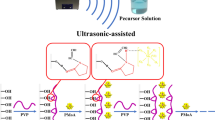Abstract
Novel UV-light and visible-light photochromic inorganic–organic multilayers composed of polyoxometalates (phosphomolybdic acid (PMoA)) and poly(acrylamide) (PAM) were prepared by the layer-by-layer (LbL) self-assembly method. The grown process, composition, surface topography, and photochromic properties and mechanism of the multilayer films were investigated by ultraviolet–visible (UV–vis) spectra, Fourier transform infrared spectra (FT-IR), atomic force microscopy (AFM), electron resonance spectra (ESR), and X-ray photoelectron spectra (XPS). Irradiation with UV-light or visible-light, the transparent films changed from colorless to blue and showed reversible photochromism. PMoA/PAM LbL films had higher photochromic efficiency under UV-light irradiation than visible-light irradiation. The bleaching process occurred when the films were in contact with O2 in the dark or heated in air. The photochromic process of PMoA/PAM LbL film was in accordance with radical mechanism.








Similar content being viewed by others

References
Yao JN, Hashimoto K, Fujishima A (1992) Photochromism induced in an electrolytically pretreated MoO3 thin film by visible light. Nature 355:624–626
Gerasimos MT, Lehn JM (1995) Photonic molecular devices: reversibly photoswitchable fluorophores for nondestructive readout for optical memory. Angew Chem Int Ed 34:1119–1122
Zhang LZ, Gu W, Dong ZL, Liu X, Li B, Liu ML (2009) Syntheses, structures and properties of a series of photochromic hybrids based on Keggin tungstophosphates. J Solid State Chem 182:1040–1044
Ben-Daniel R, Weiner L, Neumann R (2002) Activation of nitrous oxide and selective epoxidation of alkenes catalyzed by the manganese-substituted polyoxometalate, [MnIII 2ZnW(Zn2W9O34)2]10-. J Am Chem Soc 124:8788
Etienne M, Goux A, Sibottier E, Walcarius A (2009) Oriented mesoporous organosilica films on electrode: a new class of nanomaterials for sensing. J Nanosci Nanotechnol 9:2398–2406
Nakanishi T, Schmitt W, Michinobu T, Kurth DG, Ariga K (2005) Hierarchical supramolecular fullerene architectures with controlled dimensionality. Chem Commun 48:5982–5984
Michinobu T, Nakanishi T, Hill JP, Funahashi M, Ariga K (2006) Room temperature liquid fullerenes: an uncommon morphology of C60 derivatives. J Am Chem Soc 128:10384–10385
Luo XJ, Yang C (2011) Photochromic ordered mesoporous hybrid materials based on covalently grafted polyoxometalates. Phys Chem Chem Phys 13:7892–7902
Ariga K, Nakanishi T, Michinobu T (2006) Immobilization of biomaterials to nano-assembled films (self-assembled monolayers, Langmuir-Blodgett films, and layer-by-layer assemblies) and their related functions. J Nanosci Nanotechnol 6:2278–2301
Wang ZL, Zhang RL, Ma Y, Zheng LD, Peng A, Fu HB, Yao JN (2010) Transparent and flexible phosphomolybdate–agarose composite thin films with visible-light photochromism. J Mater Chem 20:1107–1111
Schlenoff JB, Dubas ST, Farhat T (2000) Sprayed polyelectrolyte multilayers. Langmuir 16:9968–9969
Ingersoll D, Kulesza PJ, Faulkner LF (1994) Polyoxometallate-based layered composite films on electrodes preparation through alternate immersions in modification solutions. J Electrochem Soc 141:140–147
Huang Y, Pan QY, Dong XW, Cheng ZX (2006) Synthesis and photochromism of a novel organic–inorganic hybrid film embedded with polyoxomatalates. Mater Chem Phys 97:431–436
Wrobel AM, Walkiewicz-Pietrzykowska A, Hatanaba Y, Wickramanayaka S, Nakanishi Y (2001) Oligomerization and polymerization steps in remote plasma chemical vapor deposition of silicon − carbon and silica films from organosilicon sources. Chem Mater 13:1884–1895
Clemente-León M, Agricole B, Mingotand C, Gómez-García C, Coronado JE, Delhaes P (1997) Application of the Langmuir–Blodgett technique to polyoxometalates: towards new magnetic film. Angew Chem Int Ed Engl 36:1114–1116
Zhang GJ, He T, Ma Y, Chen ZH, Yang WS, Yao JN (2003) Fabrication of photochromic phosphomolybdic acid monolayer film. Phys Chem Chem Phys 5:2751–2753
Gao G, Xu L, Wang W, An W, Qiu Y (2004) Electrochromic ultra-thin films based on cerium polyoxometalate. J Mater Chem 14:2024–2029
Hammond PT (2004) Form and function in multilayer assembly: new applications at the nanoscale. Adv Mater 16:1271–1293
Decher G (1997) Fuzzy nanoassemblies: toward layered polymeric multicomposites. Science 277:1232–1237
Xu L, Zhang HY, Wang EB, Kurth DG (2002) Photoluminescent multilayer films based on polyoxometalates. J Mater Chem 12:654–657
Jiang M, Wang EB, Kang ZH, Lian SY (2003) In situ controllable synthesis of polyoxometalate nanoparticles in polyelectrolyte multilayers. J Mater Chem 13:647–649
Chen ZH, Ma Y, He T, Xie RM, Shao K, Yang WS, Yao JN (2002) Modification of photochromic inorganic/organic superlattice films by organic molecules. New J Chem 26:621–624
Yao JN, Loo BH, Fujishima A, Bunsenges B (1990) A study of the photochromic and electrochromic properties of MoO3 thin films. Phys Chem 94:13–17
Bechinger C, Ferrere S, Zaban A, Sprague J, Gregg BA (1996) Photoelectrochromic windows and displays. Nature 383:608–610
Zhang GJ, Yang WS, Yao JN (2005) Thermally enhanced visible-light photochromism of phosphomolybdic acid–polyvinylpyrrolidone hybrid films. Adv Funct Mater 15:1255–1259
Mayer CR, Cabuis V, Lalot T, Thouvenot R (1999) Incorporation of magnetic nanoparticles in new hybrid networks based on heteropolyanions and polyacrylamide. Angew Chem Int Ed 38:3672–3675
Feng W, Zhang TR, Liu Y, Wei L, Lu R, Li TJ, Zhao YY, Yao YN (2002) Novel hybrid inorganic–organic film based on the tungstophosphate acid–polyacrylamide system: photochromic behavior and mechanism. J Mater Res 17:133–136
Mioč U, Colomlan P, Novak A (1990) Infrared and Raman study of some heteropolyacid hydrates. J Mol Struct 218:123–128
Prados RA, Pope MT (1976) Low-temperature electron spin resonance spectra of heteropoly blues derived from some 1:12 and 2:18 molybdates and tungstates. Inorg Chem 15:2547–2553
Pope MT (1979) Mixed-valence compounds, heteropoly blues. D. Reifel, Oxford
Chen ZH, Loo BH, Ma Y, Cao YW, Ibrahim A, Yao YN (2004) Photochromism of novel molybdate/alkylamine composite thin films. Chem Phys Chem 5:1020–1026
Feng W, Zhang TR, Liu Y, Lu R, Guan C, Zhao YY, Yao YN (2002) Preparation and photochromic properties of hybrid thin films based on heteropolyoxometalate and polyacrylamide. J Mater Sci Technol 18:558–560
Acknowledgments
The authors acknowledge the financial support from the National Natural Science Foundation of China (No. 61340048) and Industrial Technology Research and Development projects in Jilin Province (No.2013C044).
Author information
Authors and Affiliations
Corresponding author
Rights and permissions
About this article
Cite this article
Bao, Hf., Wang, Xy., Yang, Gq. et al. UV-light and visible-light photochromism of inorganic–organic multilayer films based on polyoxometalate and poly(acrylamide). Colloid Polym Sci 292, 2883–2889 (2014). https://doi.org/10.1007/s00396-014-3336-3
Received:
Revised:
Accepted:
Published:
Issue Date:
DOI: https://doi.org/10.1007/s00396-014-3336-3



